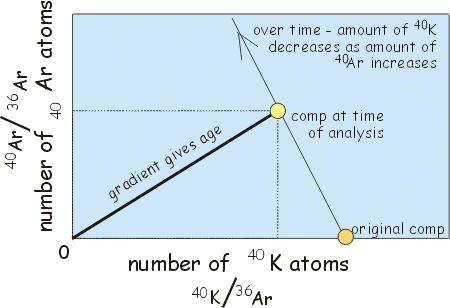 This
is a typical representation for age dating. We plot parent against daughter
concentrations. In this hypothetical example there are no daughter atoms present
in the original rock but a certain amount of parent atoms (so the composition
plots on the parent axis). Consequently a line passing through this point to
the origin has zero slope. After time a number of parent atoms have decayed
(so total goes down) and the number of daughters increase. Eventually there
will be no parents and only daughters - the composition will plot on the daughter
axis. Note therefore the gradient of line connecting any composition with the
origin increases with time. Or - the gradient of the line is a function of time.
It is also a function of the decay constant.
This
is a typical representation for age dating. We plot parent against daughter
concentrations. In this hypothetical example there are no daughter atoms present
in the original rock but a certain amount of parent atoms (so the composition
plots on the parent axis). Consequently a line passing through this point to
the origin has zero slope. After time a number of parent atoms have decayed
(so total goes down) and the number of daughters increase. Eventually there
will be no parents and only daughters - the composition will plot on the daughter
axis. Note therefore the gradient of line connecting any composition with the
origin increases with time. Or - the gradient of the line is a function of time.
It is also a function of the decay constant.
In practice however, there are commonly daughter atoms already present in
a material. In these cases we must make a correction, estimating the original
daughter concentration. We can do this by normalising against
a stable isotope of the daughter atom (argon 36 for the K-Ar system; strontium
86 for the Rb-Sr system).
Dating rocks

 This
is a typical representation for age dating. We plot parent against daughter
concentrations. In this hypothetical example there are no daughter atoms present
in the original rock but a certain amount of parent atoms (so the composition
plots on the parent axis). Consequently a line passing through this point to
the origin has zero slope. After time a number of parent atoms have decayed
(so total goes down) and the number of daughters increase. Eventually there
will be no parents and only daughters - the composition will plot on the daughter
axis. Note therefore the gradient of line connecting any composition with the
origin increases with time. Or - the gradient of the line is a function of time.
It is also a function of the decay constant.
This
is a typical representation for age dating. We plot parent against daughter
concentrations. In this hypothetical example there are no daughter atoms present
in the original rock but a certain amount of parent atoms (so the composition
plots on the parent axis). Consequently a line passing through this point to
the origin has zero slope. After time a number of parent atoms have decayed
(so total goes down) and the number of daughters increase. Eventually there
will be no parents and only daughters - the composition will plot on the daughter
axis. Note therefore the gradient of line connecting any composition with the
origin increases with time. Or - the gradient of the line is a function of time.
It is also a function of the decay constant.